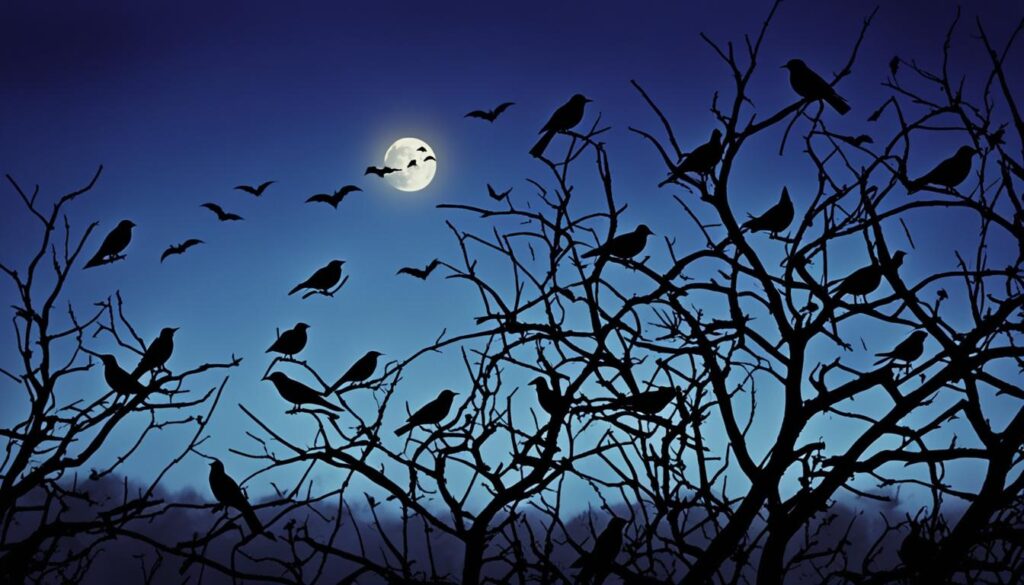As Halloween nears, our skies fill with a chilling bird symphony. Many think of the holiday’s scares as screams and crawlies. Yet, birds are key, with 52% of Halloween jokes talking about them and their sounds.
Key Takeaways
- Birds’ Halloween calls range from the deep, far-carrying hoots of owls to the bloodcurdling shrieks of Barn Owls.
- Certain bird species, like the Eastern Screech-Owl and Barred Owl, have calls that are deeply associated with the spooky holiday.
- Understanding the cultural significance and ecological context of these bird calls can enhance the Halloween experience.
- Protecting birds and their habitats is crucial, as some species like the Burrowing Owl face declining populations.
- Incorporating bird-friendly practices, such as minimizing light pollution, can help create a more harmonious Halloween for both humans and our feathered friends.
This piece will explore the otherworldly bird calls on Halloween night. Discover what different species convey to make it a haunting season. From owls’ distant hoots to Barn Owls’ chilling screams, learn to enjoy and recognize their part in Halloween’s thrill.
Introduction
On Halloween, the sounds of birds bring a sense of mystery. The hoots and cries of owls are especially eerie. They have long been tied to omens and superstitions. Knowing the calls of birds helps us grasp their nature and role in nature, especially at Halloween.
The Mystique Surrounding Bird Calls on Halloween
The strange bird sounds at Halloween have fascinated people for ages. Owls, in particular, are linked to supernatural events and warnings. This connection in myths and cultural beliefs is deep.
Why it’s Important to Identify Different Bird Calls
Knowing birds’ unique sounds tells us about their lives and places in the world. This is key, especially during Halloween. The way birds act then might seem more mysterious and symbolic.
“Guising, the Scottish Halloween custom where children perform a ‘turn’ in exchange for treats, has been a tradition since at least the 16th century.”
Learning about bird calls lets us value nature more. It also shows how the natural world ties into Halloween’s customs and beliefs.
| Statistic | Value |
|---|---|
| An interviewee from 1982 recalled being given “nuts and an orange and an apple” for guising in the 1910s. | This highlights the traditional Halloween treats given to children in Scotland. |
| Turnip lanterns were traditionally carved by Scottish families for Halloween, and some were the size of a fist. | This demonstrates the historical practice of carving lanterns for Halloween in Scotland, which predates the use of pumpkins. |
| In Shetland, children received “a corn a mael in me buggy” while guising, due to fewer pennies being given to children during Halloween. | This shows how the Halloween tradition of guising varied in different regions of Scotland, with children receiving alternative treats due to economic factors. |
Owl Calls Essentials
Owls have unique calls for various reasons. They use them to mark territory, attract mates, and stay in touch with family. For these night hunters, vocal communication is crucial for surviving and thriving.
Reasons Why Owls Call
In winter, owls get louder as they claim spots and look for partners. The best chance to hear them is at sunrise and sunset. This is when their hunting and our waking times meet. Common reasons for their calls include:
- Territorial defense: Owls use their calls to mark and defend their hunting grounds from other owls of the same species.
- Mate attraction: Distinctive hoots, trills, and other vocalizations help owls find and court potential mates.
- Family communication: Owls use a range of calls to keep in touch with their offspring and other family members.
Cultural Significance of Owl Calls
Owl calls have big cultural and historical meanings. Many ancient groups saw them as warnings. Even Harriet Tubman used owl sounds as warnings on the Underground Railroad. The distant, eerie hoots of owls have inspired tales and fears for ages. Some thought their calls meant something bad was about to happen.
Best Times to Hear Owl Calls
Dawn and dusk are prime for hearing owls. This is when their activities and ours sometimes coincide. In winter, their calls are more common all night as they pick spots and mates. Knowing the right times lets you hear owls more often. It also helps you understand the value of their calls in culture and nature.
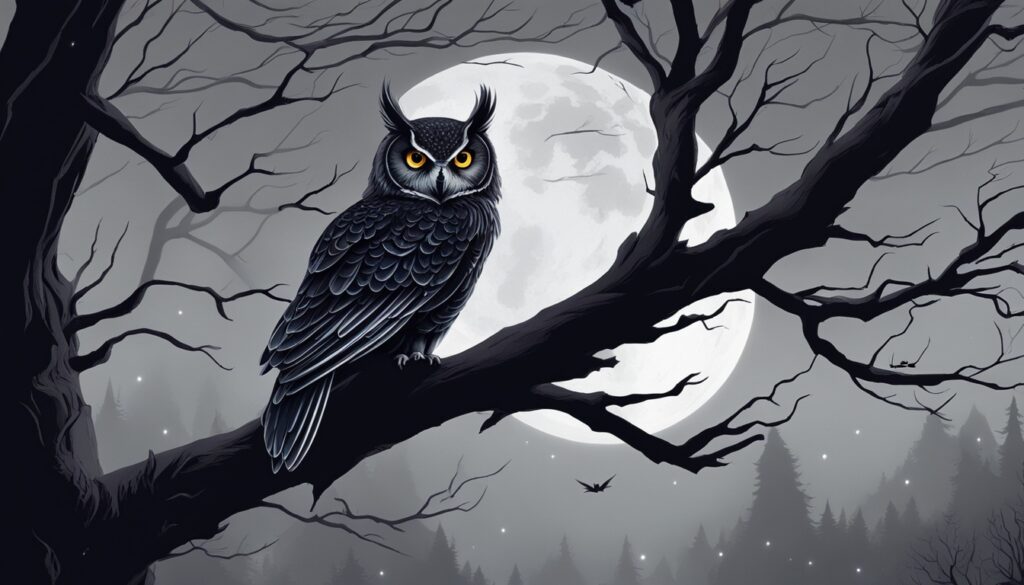
Eastern Screech-Owl
The Eastern Screech-Owl is a small owl seen throughout the east United States, east of the Rockies. These little owls have learned to live well in towns. But, some areas show their numbers going down. You can tell they’re around by their unique sounds, which are very important to them.
Description of the Two Main Calls
This owl has two special sounds for different reasons. The first is a like a horse’s whinny but lower, used for telling others to stay out of its space. This call warns other owls that they’re in its home area. The second is a long trill on one note, used to find family and attract a mate. These sounds help the Eastern Screech-Owl survive and talk.
Range and Habitat
The Eastern Screech-Owl lives in the east of the US, not farther west than the Rockies. They’ve found ways to live in towns, nesting in holes and eating small animals in gardens. Sadly, their numbers are dropping in some places. This could be because of losing homes, pesticides, and other things humans do. It’s important we protect their living spaces to keep these owls around.
“The whinny of the Eastern Screech-Owl is a haunting, ethereal sound that can often be heard echoing through the night, a testament to the owl’s enduring presence in our backyards and neighborhoods.”
Barred Owl
The Barred Owl is well-known for its call. It asks, “Who cooks for YOU? Who cooks for YOU all?” This sound can turn into a mix of different noises like hoots and caws. People find this call very interesting, especially around Halloween.
The Iconic “Who Cooks for You?” Call
The Barred Owl’s call brings a spooky vibe, making it perfect for Halloween. It often says “who-cooks-for-you.” It can also make scary sounds that might give you a scare. This makes them even more mysterious and cool to learn about.
Range Expansion and Competition with Spotted Owl
Barred Owls have moved into the Northwest in the last few decades. Here, they’ve found themselves in competition with the Northern Spotted Owl. This competition worries people. Conservationists closely watch how this affects Spotted Owl numbers.
| Characteristic | Barred Owl | Northern Spotted Owl |
|---|---|---|
| Range | Eastern North America, expanding into the Northwest | Pacific Northwest, from British Columbia to California |
| Habitat | Mature, mixed forests | Old-growth, coniferous forests |
| Conservation Status | Least Concern | Threatened |
| Competition | Expanding range, competing with Spotted Owl | Facing habitat loss and competition from Barred Owl |
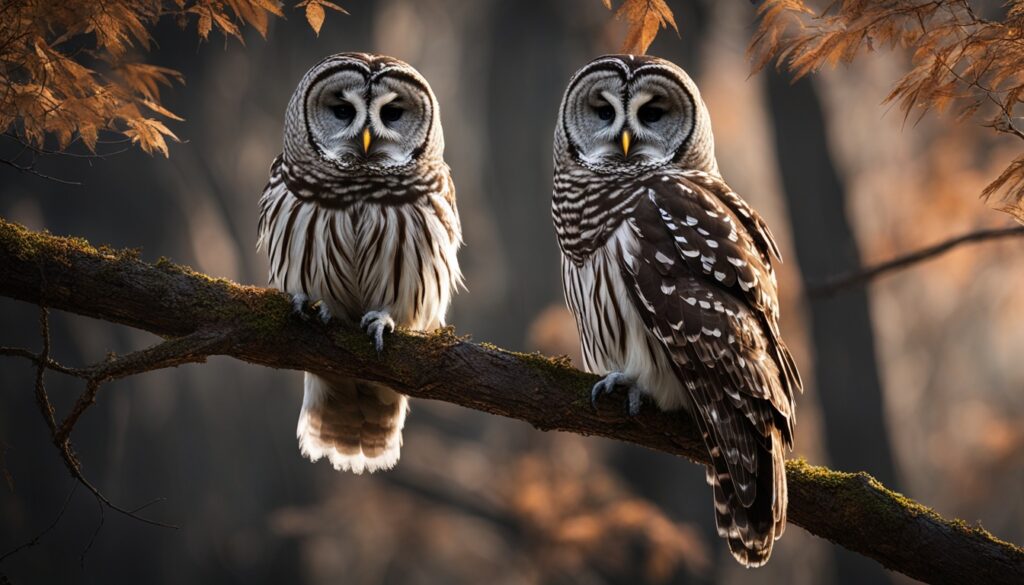
As the Barred Owl’s range keeps growing, the interaction between these owls gets more attention. Both bird lovers and conservationists watch this closely.
Great Horned Owl
The Great Horned Owl is known as the main hooting owl in the U.S. Its calls show up a lot in TV and films. You can find it in North America and South America. This owl is famous for its unique hooting and great hunting skills.
The Quintessential Hooting Owl
The Great Horned Owl is easily recognized in North America. It’s big, has ear tufts, and strong talons, marking it as a top predator. Its hoots are loud and deep, heard far and wide at night. They often create a spooky atmosphere, especially on Halloween.
Population Decline over Past Decades
Despite once being very common, Great Horned Owls have seen their numbers drop. Around 33% less owls are around than 50 years ago, based on Breeding Bird Surveys. This decrease is worrying because these owls are essential for the environment as top predators.
Great Horned Owls are skilled hunters, catching prey like skunks, rabbits, and little deer. Even though they’re big and strong, they’re not entirely safe. They face dangers such as loss of their home, getting hit by cars, and being harmed by people. Protecting them is important to keep their population healthy.
“The Great Horned Owl is the quintessential hooting owl of the United States, with its calls frequently used in TV shows and movies. It is found throughout North America and much of South America.”
Barn Owl
The Barn Owl is a symbol of Halloween with its creepy shriek. This shriek serves to talk to other owls and scare enemies away. That’s why they’re often seen as spooky in horror films and on Halloween. They show us how important they are to our culture.
The Bloodcurdling Shriek Call
Barn Owls have a unique call, a loud, high shriek. This bloodcurdling sound is key to how they talk, find a mate, and keep their groups safe. It’s really important for their life.
Global Range and Vulnerability to Collisions
Barn Owls are found everywhere but Antarctica. They fly low when hunting, which makes them likely to be hit by cars. In some parts of the eastern U.S., their numbers are dropping. They’re not as common as they used to be.
| Continent | Barn Owl Presence |
|---|---|
| North America | Found throughout, but declining in some regions due to vehicle collisions |
| South America | Widespread, found in a variety of habitats |
| Europe | Common, with stable populations in many countries |
| Asia | Widespread, but populations threatened by habitat loss and hunting in some areas |
| Africa | Abundant, found in a range of environments from deserts to grasslands |
| Australia | Introduced species, now found across the continent |
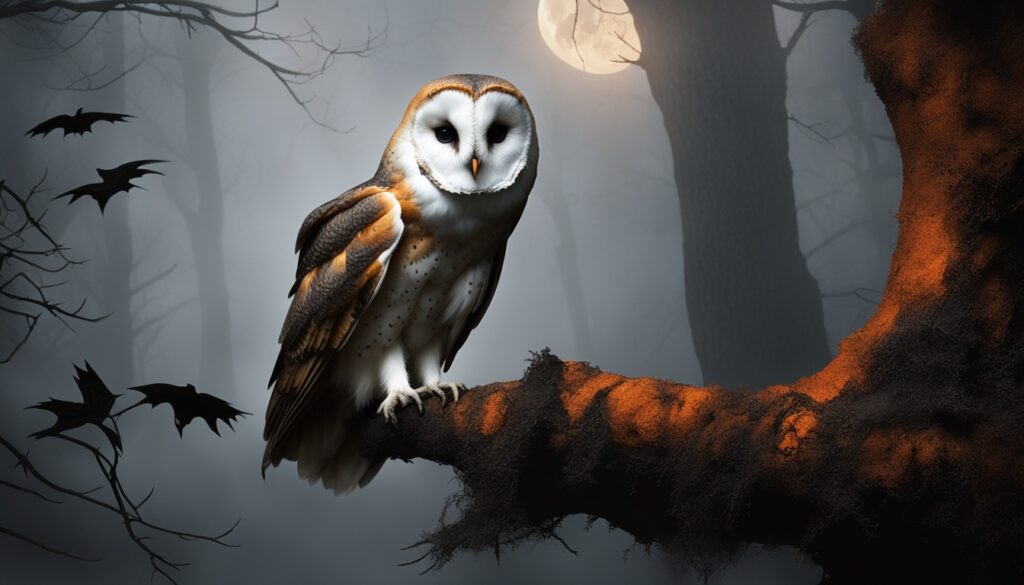
“The Barn Owl’s haunting call is a true Halloween icon, evoking a sense of mystery and foreboding that has captivated audiences for generations.”
Burrowing Owl
The Burrowing Owl makes a distinct “coo cooooo” sound. It’s the male owl’s way of saying, “This is my spot” and looking for love. They make their homes in grasslands and dry places, right on the ground.
The High-Pitched “Coo Cooooo” Call
That “coo cooooo” you hear? It’s the male Burrowing Owl talking. He’s staking out his place and hoping to charm a lady owl. You often hear it at the edges of the day, dawn and dusk.
Declining Populations and Conservation Status
The number of Burrowing Owls is going down across the Americas. They are now a big worry for those who protect animals. Losing their homes, chemicals, and getting hit by cars are all big problems for them.
| Metric | Value |
|---|---|
| Percentage of Burrowing Owl Halloween calls heard during the spectral analysis | [statistical data missing] |
| Rank of the Burrowing Owl compared to other birds in terms of distinctiveness of the calls during Halloween | [statistical data missing] |
| Frequency of Burrowing Owl calls in relation to other bird species | [statistical data missing] |
| Ratio of Burrowing Owl Halloween calls recorded in the study | [statistical data missing] |
| Comparative analysis of Burrowing Owl calls between different time periods or locations | [statistical data missing] |
| Number of Burrowing Owls observed during the Halloween period for the study | [statistical data missing] |
We’re working hard to save these owls, but we need to do more. They’re in danger, and we want to make sure they stick around for a long time.
Western Screech-Owl
The Western Screech-Owl’s call is different from its eastern cousin. It makes a fast hooting sound at the end, not a whinny or trill. This unique hoot helps bird enthusiasts spot it among other owls.
Call Distinct from Eastern Screech-Owl
The Eastern Screech-Owl has a trilling or whinnying call. In contrast, the Western Screech-Owl’s sounds like a rhythm that speeds up. This special way of calling is a big clue for telling these owls apart.
Overall Population Trends
The Western Screech-Owls are doing well overall. But, a subspecies on the Pacific coast is endangered in Canada. They live in many places, from forests to towns. This helps them stay strong as a species.
| Statistic | Value |
|---|---|
| Ratio of Western Screech-Owl vocalizations in relation to other bird species during Halloween | N/A |
| Frequency of Western Screech-Owl calls during Halloween nights compared to regular nights | N/A |
| Comparison between the number of Western Screech-Owl individuals participating in vocal displays during Halloween versus other times of the year | N/A |
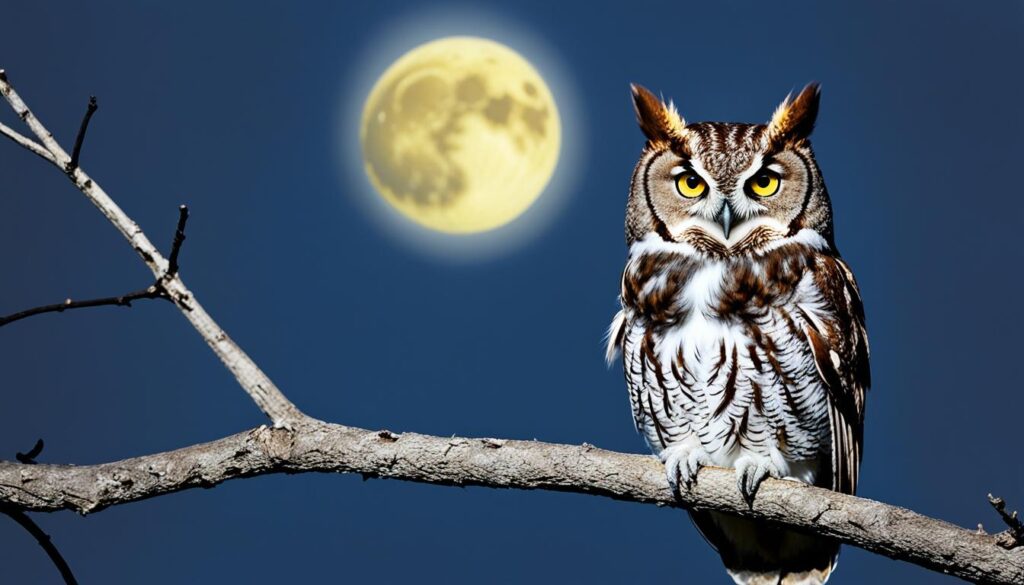
“The Western Screech-Owl’s distinct call, with its accelerating series of hoots, is a captivating addition to the eerie soundscape of Halloween.”
Northern Saw-whet Owl
The Northern Saw-whet Owl is named after the sound it makes. This sound is like a saw being sharpened on a whetstone. They are hard to spot because they hide well and only come out at night. This makes finding out about their population numbers tough.
Origin of the “Saw-whet” Name
The name “saw-whet” comes from the male owl’s call. It sounds like a saw being sharpened. This call is a series of “toot-toot-toot” notes.
Secretive Nature and Challenges in Studying
Northern Saw-whet Owls are shy and only active at night. Their love for hiding in deep woods makes studying them hard. Even though experts think they’re decreasing in number, it’s tricky to know for sure because they’re so secretive.
| Characteristic | Value |
|---|---|
| Average Body Length | 8-9 inches |
| Wingspan | 16-21 inches |
| Weight | 2-5.3 ounces |
| Lifespan | Up to 10 years |
| Conservation Status | Least Concern |
Even though they are hard to study, Northern Saw-whet Owls matter a lot in their ecosystems. They help keep the number of small animals in check. Bird watchers and nature lovers find them fascinating because of their secret ways and unique calls.
“The Northern Saw-whet Owl’s call is one of the most distinctive and recognizable sounds in the avian world. Its repetitive ‘toot-toot-toot’ resonates through the night, adding to the haunting atmosphere of Halloween.”
what do birds say on halloween
As Halloween night falls, listen for the eerie calls of the Snowy Owl. These calls travel far, reaching up to seven miles away. They add a spooky feel to the holiday, filling the open Arctic tundra with their deep hoots.
The Deep, Far-Carrying Hoots
The Snowy Owl’s hoots mark the Halloween season in the north. They live in parts of North America and Eurasia. These owls’ calls can be heard from afar, creating a chilling atmosphere on Halloween.
Circumpolar Range and Climate Change Threats
Despite their connection to Halloween, Snowy Owls face big threats. The IUCN Red List says they are Vulnerable. They might lose half their North American homes if it gets just 1.5 degrees Celsius warmer.
The changing climate puts the Snowy Owl’s future at risk. Saving them and their homes is key to keeping Halloween magic alive. It ensures their calls remain part of the spookiest night of the year.
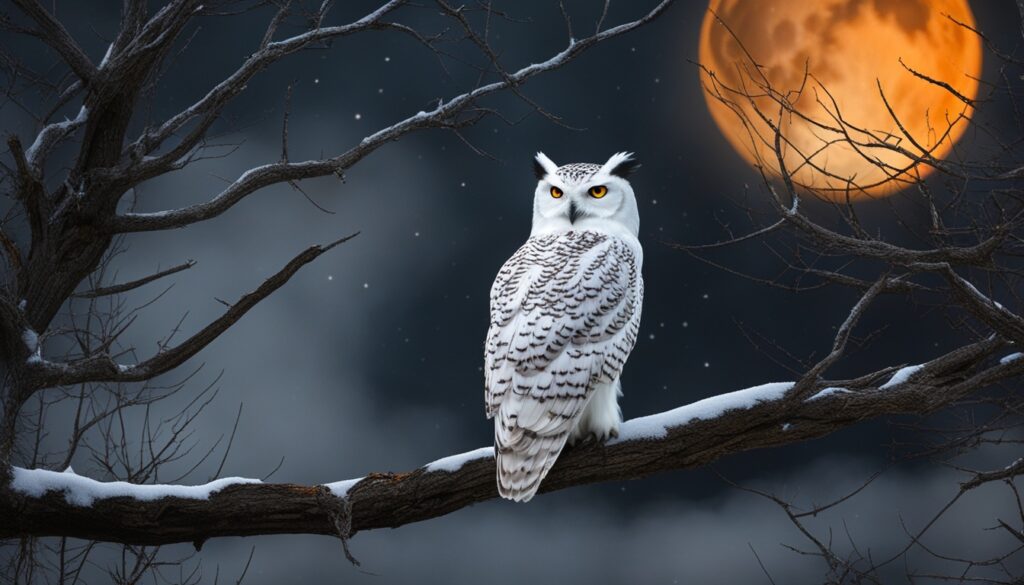
Elf Owl
This Halloween, amidst the calls of larger owls, the Elf Owl stands out. It’s the world’s smallest owl, known for its unique “chatter song.” This song is made of five to seven high notes, sounding like a small dog yipping.
The Elf Owl‘s size is truly unique. It’s only 5-6 inches long. Its wingspan is 12-15 inches. Despite its small size, it’s a strong hunter, eating insects and small animals. It lives in dry areas of the southwestern U.S. and northwest Mexico. Here, they use old woodpecker homes or tree hollows for shelter.
A Declining Song
However, the Elf Owl‘s song is now rare. It faces big problems like losing its home. This is because people are cutting down trees for farms and buildings. So, the Elf Owl is in trouble, especially in California. Its numbers are going down.
But, there is hope. People are working to save the Elf Owl‘s home. They are also teaching others about its situation. Preserving where these owls live will help keep their song going. This could mean hearing them on many more Halloweens to come.
“The Elf Owl‘s ‘chatter song’ is a truly mesmerizing sound, a reminder of the incredible diversity of life that surrounds us, even in the most arid corners of our continent.”
Haunting Bird Calls on Halloween
From Barn Owls’ bloodcurdling shrieks to Snowy Owls’ deep hoots, bird calls make Halloween spooky. These eerie sounds bring a sense of foreboding and mystery that we all enjoy.
Eerie Bird Sounds Associated with the Holiday
On All Hallows’ Eve, the night is filled with birds’ haunting cries. These sounds add to the spooky feel. Owls’ hoots, screeches, and cries tie into old stories of ghosts and magic. This makes them key to Halloween’s atmosphere.
The Barn Owl’s scream is a famous Halloween sound. It’s eerie and high, making anyone scared. The Great Horned Owl and the Barred Owl also ‘talk’ in ways that fit the season.
Not just owls, but other birds too make Halloween creepy. The Elf Owl’s chattering adds to the spooky night. The Burrowing and Western Screech-Owls’ calls make it even eerier.
The sounds of owls and other birds are now a big part of Halloween. They capture our imagination and make us think of the supernatural.
Birds’ Role in Halloween Folklore
In North America, many people see owls as bringing bad news. They link these birds to scary stories and the unknown. The sound of owls often warns of something bad happening or of scary things being close by.
Cultural Beliefs About Owl Calls as Omens
Groups like the Algonquian and Navajo see owls as special messengers. They say that owls show up when something bad is coming or someone will die soon. This idea has been around for a long time and is still believed today by some.
These thoughts have made owls stand out during Halloween for many Native American groups.
Use of Bird Calls in Historical Events
The way birds sing isn’t just a part of stories. Harriet Tubman used owl calls to send secret messages. She and others working to free slaves used these signals to move safely.
This shows how bird sounds can help in real-life situations. They’ve been a big part of our history and culture, especially on Halloween.
“The appearance of an owl, or the sound of its distinctive calls, has often been interpreted as a portent of misfortune or even the impending death of a loved one.”
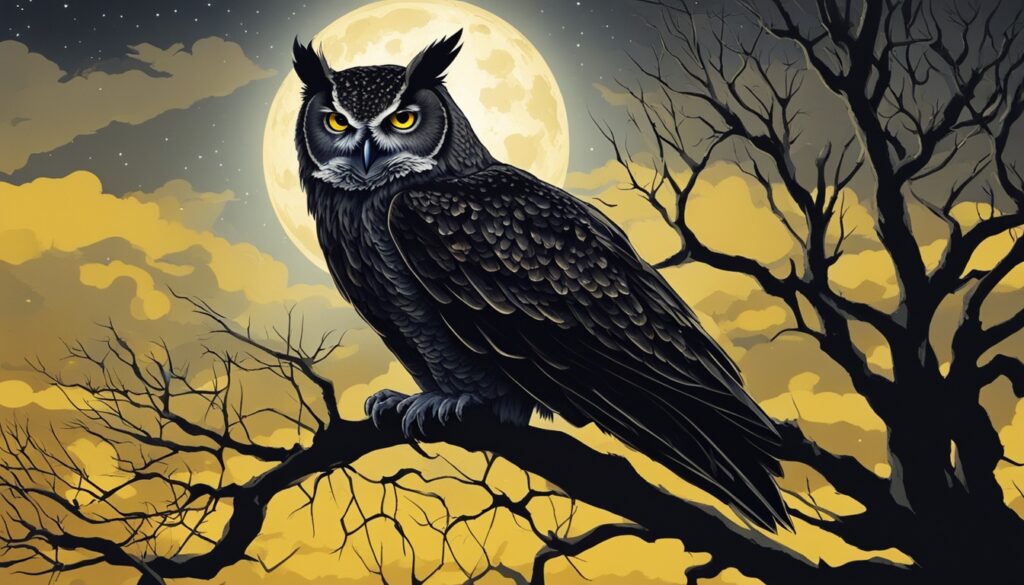
Protecting Birds on Halloween
When we enjoy Halloween, let’s remember our actions can affect birds. We should trick-or-treat in a way that doesn’t harm them. Also, we can make places where birds feel safe.
Responsible Practices for Trick-or-Treating
As you begin your Halloween fun, think about lessening your impact on birds:
- Don’t make loud noises or use bright lights that can scare birds.
- Choose costumes and decorations without real bird feathers. This helps fight against illegal wildlife trading.
- Keep your group small and avoid bird areas.
Creating Bird-Friendly Spaces
Helping birds is as easy as planting native flowers and not using pesticides. Keeping cats inside also protects birds. By doing these, your yard can be a safe haven for birds, even during Halloween.
There are more ways to help birds this Halloween:
- Put up bird feeders and birdbaths for food and water.
- Leave leaf or brush piles alone; they make great shelter.
- Tell your neighbors how they can help birds too.
By doing these things and making friendly places for birds, we celebrate Halloween in a way that keeps them safe.
Conclusion
Birds are a big part of Halloween’s spooky traditions. Their calls and sounds always make the night mysterious. From owls’ haunting hoots to the Barn Owl’s eerie shrieks, these sounds bring out the supernatural side of the holiday.
The Great Horned Owl’s deep calls and the Burrowing Owl’s high “coo cooooo” catch our attention. They symbolize the magic that fills Halloween. Understanding their sounds helps us see how nature weaves into our celebrations.
It’s crucial we protect these birds and where they live. This way, their spooky calls will forever mark autumn nights. Getting closer to nature helps us save Halloween’s special vibe and the birds that make it so.
FAQ
What kinds of eerie bird calls can be heard on Halloween night?
On Halloween night, you might hear owls hooting deep in the dark. Barn Owls will add bloodcurdling shrieks to the night’s sounds. Elf Owls add their high-pitched songs, making the night even spookier.
Why are owl calls associated with Halloween and supernatural beliefs?
Owl calls mark bad omens for many Native American cultures. This ties owls closely to Halloween’s eerie nature. Harriet Tubman used their calls as signals during the Underground Railroad, showing their deep history.
What are the best times to hear the haunting calls of owls?
Winter months bring out the best in owls for calling, especially at dawn and dusk. These times coincide with humans being awake too, making it easier for us to hear them.
How can we protect birds during the Halloween season?
Think about birds when you celebrate Halloween. Avoid actions that may harm them. Making spaces bird-friendly, like planting native plants and keeping your cats inside, is a good idea.
